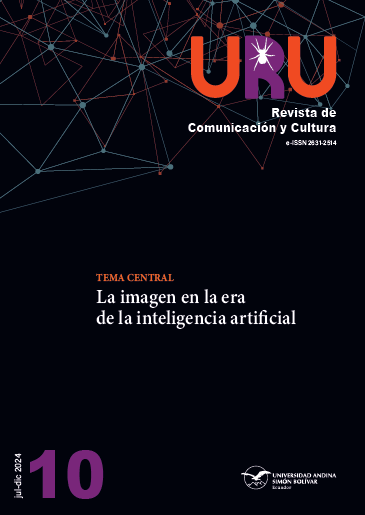Metadesigners: Symbiosis of Digital Tools and Artificial Intelligence in Architectural Design
DOI:
https://doi.org/10.32719/26312514.2024.10.3Keywords:
Artificial intelligence in architecture, metadesigners, architectural innovation, digital tools, technological intersection in designAbstract
Throughout the 21st century, we have witnessed a paradigmatic metamorphosis in the field of architectural design, based on innovation and the use of digital tools. This evolutionary process has led to the emergence of a generation of professionals identified as “metadesigners”, whose distinction lies in their interdisciplinary approach that amalgamates architectural creation with research. Perceptive to the pervasive influence of digital systems in the contemporary world, metadesigners are emerging as protagonists in the reconfiguration of professional practices. However, the most far-reaching change has manifested itself in recent months with the proliferation and exponential development of tools based on artificial intelligence (AI), which have revolutionized
the process of generating images and designs in architecture. AI has demonstrated its capacity to conceive creative and innovative solutions, marking a real turning point in this field. Starting from these premises and based on the hypothesis that the intersection between AI and architecture is intrinsically transforming the design process, enhancing both communicative efficiency and design quality, this paper aims to investigate and evaluate the effectiveness and efficiency of these processes, considering their impact on the quality and originality of the designs. Finally, this analysis aims to deepen the understanding of the emerging dynamics between AI and architecture, in order to continuously enrich this field and its relationship with contemporary society.
Downloads
References
Alawadhi, Mohammad, y Wei Yan. 2021. “BIM Hyperreality: Data Synthesis Using BIM and Hyperrealistic Rendering for Deep Learning”. Ponencia presentada en la 40th Annual Conference of the Association for Computer Aided Design in Architecture (ACADIA 2020). https://doi.org/10.48550/arXiv.2105.04103. DOI: https://doi.org/10.52842/conf.acadia.2020.1.228
As, Imdat, Siddhart Pal y Prithwish Basu. 2018. “Artificial Intelligence in Architecture: Generating Conceptual Design Via Deep Learning”. International Journal of Architectural Computing 16 (4): 306-27. https://doi.org/10.1177/1478077118800982. DOI: https://doi.org/10.1177/1478077118800982
Carpo, Mario. 2009. “Revolución 2.0: El fin de la autoría humanista”. Arquitectura Viva 124: 19-25. https://tinyurl.com/747whe7m.
Del Campo, Matías, y Neil Leach. 2022. “Can Machines Hallucinate Architecture? AI as Design Method”. Architectural Design 92 (3): 6-13. https://doi.org/10.1002/ad.2807. DOI: https://doi.org/10.1002/ad.2807
—, Sandra Manninger y Alexandra Carlson. 2020. “The Robot Garden: Architecture and AI”. SPAN. https://tinyurl.com/2b3rectp.
—, Sandra Manninger, Marianne Sanche y Leetee Wang. 2019. “The Church of AI: An Examination of Architecture in a Posthuman Design Ecology”. Ponencia presentada en la 24th CAADRIA Conference, Wellington, Nueva Zelanda. https://tinyurl.com/c3p9uvbh.
Estalella, Adolfo. 2015. “Colectivos de arquitectura: Otra sensibilidad urbana”. Prototyping. 12 de enero. https://tinyurl.com/mr5baf75.
Estévez, Alberto, y Yomna Abdallah. 2022. AI to Matter-Reality: Art, Architecture & Design. Barcelona: iBAG-UIC Barcelona.
Farson, Richard. 1995. “Metadiseño: Hacia una redefinición del diseño”. Revista Domus 772.
Feghali, Yara. 2017. “Leaky L. A.”. Yara Feghali. https://tinyurl.com/mr2f6ef2.
Fraile, Marcelo. 2019. Arquitectura biodigital. Buenos Aires: Diseño.
Jencks, Charles. 2000. “Jencks’ Theory of Evolution, an Overview of 20th Century Architecture”. The Architectural Review. 12 de julio. https://tinyurl.com/2u7ex8u5.
Kalwill, Matías. 2008. “La idea del metadiseño y la necesidad de un nuevo enfoque”. Abre el Ojo. Revista del IED Madrid 9: 130-32. https://tinyurl.com/mutab5w8.
Kolarevic, Branco. 2003. “Digital Morphogenesis”. En Architecture in the Digital Age: Design and Manufacturing, editado por Branko Kolarevic, 17-45. Londres: Taylor & Francis.
Mondragón, Hugo, y Claudio Labarca. 2009. “Editorial: Fabricación y tecnología digital”. En mARQ 04: Fabricación y tecnología digital, editado por Hugo Mondragón y Claudio Labarca, 7-9. Santiago de Chile: Pontificia Universidad Católica de Chile.
Montaner, Josep Maria. 2015. La condición contemporánea de la arquitectura. Barcelona: Gustavo Gili.
Pinochet, Diego. 2009. “Forma digital/forma construida: Diseño y construcción de sistemas emergentes a partir de algoritmos generativos”. En mARQ 04: Fabricación y tecnología digital, editado por Hugo Mondragón y Claudio Labarca, 37-44. Santiago de Chile: Pontificia Universidad Católica de Chile.
Prestinenza Puglisi, Luigi. 2009. “Anything Goes”. Architectural Design 79 (1): 6-12. https://doi.org/10.1002/ad.798. DOI: https://doi.org/10.1002/ad.798
Rehm, M. Casey, y Damjan Jovanovic. 2022. “Assembled Worlds: New Campo Marzio–Piranesi in the Age of AI”. Architectural Design 92 (3): 80-5. https://doi.org/10.1002/ad.2817. DOI: https://doi.org/10.1002/ad.2817
Sastre, Paz. 2016. “Perfomatividad y arte computacional: Hacia una ‘DIY society’”. Teknokultura. Revista de Cultura Digital y Movimientos Sociales 13(1): 193-215. http://dx.doi.org/10.5209/rev_TK.2016.v13.n1.51782. DOI: https://doi.org/10.5209/rev_TK.2016.v13.n1.51782
Schmitt, Gerhard. 1999. Information Architecture: Basis and Future of CADD. Berlín: Birkhäuser.
Sheikh, Knvul. 2020. “A Growing Presence on the Farm: Robots”. The New York Times. 13 de febrero. https://tinyurl.com/yc8yrpaz.
Teixeira de Almeida, Camila. 2014. “O conceito de metadesign: O colloquium on metadesign, na Universidade Goldsmiths em Londres”. Blucher Design Proceedings 1 (8): 62-6. https://tinyurl.com/mppha8vw. DOI: https://doi.org/10.5151/despro-sigradi2014-0008
Vassão, Caio. 2010. Metadesign: Ferramentas, estratégias e ética para a complexidades. São Paulo: Bluche.
Virilio, Paul. 1996. El arte del motor: Aceleración y realidad virtual. Buenos Aires: Manantial.
Wood, John. 2015. “Collective Metamorphosis: A Combinatorial Approach to Transformation Design”. En Transformation Design: Perspectives on a New Design Attitude, editado por Jonas Wolfgang, Sarah Zerwas y Kristof von Anshelm, 246-62. Berlín: Birkhäuser. DOI: https://doi.org/10.1515/9783035606539-018
Published
How to Cite
Issue
Section
License
Copyright (c) 2024 Uru: Revista de Comunicación y Cultura

This work is licensed under a Creative Commons Attribution-NonCommercial-ShareAlike 4.0 International License.
ASSIGNMENT OF RIGHTS, DECLARATION OF CONFLICT OF INTEREST AND DISSEMINATION
The authors who publish in this journal accept the following conditions:
- Authors retain copyright and grant the journal the right of first publication, with the work registered under the Creative Commons Attribution-NonCommercial-ShareAlike 4.0 License, which allows sharing, adapting and attributing the work (see: Open Access Policies).
- Authors can make other independent and additional contractual agreements for the distribution of the article published in this journal (e.g., include it in an institutional repository or publish it in a book) as long as they expressly indicate that the article was published for the first time in Uru: Revista de Comunicación y Cultura. In the case of reproduction, a note similar to the following must be included: This text was originally published in the journal Uru: Revista de Comunicación y Cultura N ° -, year of publication.
- Authors are encouraged to publish their work on the Internet (e.g. on institutional or personal pages) in the final version published by Uru: Revista de Comunicaicón y Cultura as it may lead to a wider and faster dissemination of the published work.









